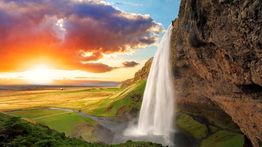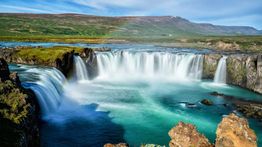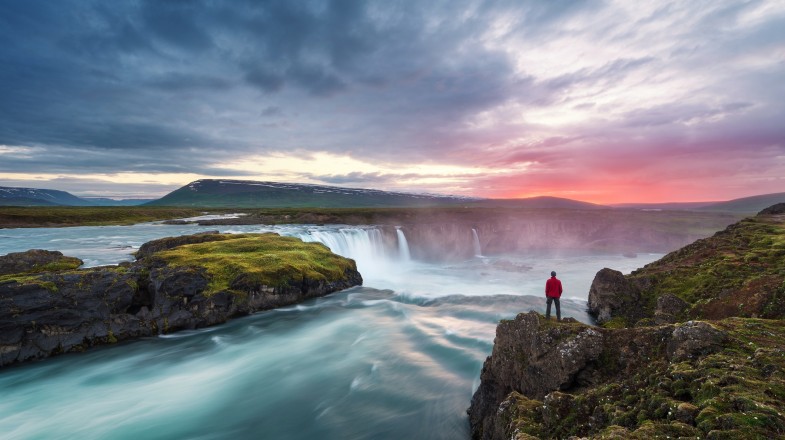Iceland in March: Weather, Tips & Northern Lights
Although it is cold in Iceland in March, this month does not fall under the country’s peak winter season. Therefore, there are lots of things to do on your Iceland trip in winter, from participating in unique festivals and events and exploring stunning ice caves to taking a dip in the healing waters of natural hot springs, embarking on an Iceland Northern Lights tour, and going on whale-watching tours. In addition to this, Iceland’s weather in March is chilly, and the country receives few travelers during this time, allowing you to take advantage of off-season rates.
- Trish C.
- From USA
Iceland Weather in March

Iceland’s weather in March is cold, even though this month falls on the tail end of the country’s winter season. The average low temperature in Iceland in March is -2.2 °C, while the average highs hover at around 3.3 °C.
Iceland does receive some rain in March and, if you are traveling to the northern parts of the country, you are likely to encounter snow as well. If you are coming to Iceland from a non-Arctic zone, the daylight hours will seem ‘normal’. On March 1, the country gets ten hours and ten minutes of daylight. However, by the end of this month, this shoots up to 13 hours and 26 minutes.
For an in-depth seasonal overview, check out our travel guide on the best time to visit Iceland.
Weather in Iceland in March - Rainfall and Temperatures
| Jan | Feb | Mar | Apr | May | Jun | Jul | Aug | Sep | Oct | Nov | Dec | |
|---|---|---|---|---|---|---|---|---|---|---|---|---|
| Avg Daily (°C) | 2 | 2 | 2 | 5 | 8 | 12 | 13 | 13 | 9 | 6 | 3 | 1 |
| Avg Nightly (°C) | -1 | -1 | -1 | 1 | 4 | 7 | 9 | 8 | 5 | 2 | 0 | -2 |
| Avg Daily (°F) | 36 | 36 | 36 | 41 | 47 | 54 | 56 | 56 | 49 | 43 | 38 | 34 |
| Avg Nightly (°F) | 31 | 31 | 31 | 34 | 40 | 45 | 49 | 47 | 41 | 36 | 32 | 29 |
| Avg Rainfall (mm) | 47 | 33 | 40 | 36 | 32 | 25 | 25 | 37 | 40 | 30 | 29 | 35 |
| Feb | Mar | Apr | |
|---|---|---|---|
| Avg Daily (°C) | 2 | 2 | 5 |
| Avg Nightly (°C) | -1 | -1 | 1 |
| Avg Daily (°F) | 36 | 36 | 41 |
| Avg Nightly (°F) | 31 | 31 | 34 |
| Avg Rainfall (mm) | 33 | 40 | 36 |
Why Visit Iceland in March


March is the last winter month. Below are the reasons why you should consider a trip to Iceland during this time of year.
- Longer days: After several months of cold and dark days, daylight hours finally start increasing in March.
- Great discounts: March is an off-season month as far as tourism in Iceland is concerned. Therefore, you can expect some cool deals on hotel tariffs and airfare if you are heading for the country during this time of year.
- Thin crowds: With the summer tourist rush still a few months away, you can enjoy Iceland’s top sights minus the crowds in March.
- Northern Lights: Though days start getting longer from March, the famous dancing auroras are still very much visible in the night sky. They are best seen from the countryside, away from cities and towns.
- Exciting events: There are a handful of festivities on Iceland’s calendar in March. The Food and Fun Festival, for example, sees chefs from around the world collaborate with local restaurants to produce new and innovative dishes. If you have music on your mind, check out Iceland’s Battle of the Bands and the Reykjavik Folk Festival. There is also the Reykjavik Fashion Festival. Held towards the end of March, this festival showcases cutting-edge Icelandic designs.
Where to go and what to do

Always wanted to see the Northern Lights? March is a great month to tick this off your bucket list. Chances of spotting these dazzling auroras increase when the sky is clear and dark and the amount of solar activity is just right. This is also the season to visit the cool, blue ice caves located underneath the Vatnajokull Glacier, one of Iceland’s top-rated attractions. There are plenty of guided tours to the glacier available.
Going on Iceland whale-watching tours is something that is suitable all year round in Iceland. However, in March, whales start returning from their summer breeding grounds. Of all the whale species, humpback whales and minke whales are the easiest to spot. Snorkeling and diving in the freezing cold are also becoming increasingly popular and are one of the activities that should be on the list of travelers heading for Iceland in March. The best place to take a plunge is the Silfra Fissure located in Thingvellir National Park. This is considered to be the only site in the world where you get to dive or snorkel between two tectonic plates. March is also an excellent time to experience Iceland’s remarkable glaciers, which cover ten percent of the country’s surface. Sign up for a glacier-hiking trip to the Solheimajokull Glacier, located about 160 km south of Reykjavik.
Another popular winter activity in Iceland is snowmobiling, which can be done in Langjokull or Vatnajokull Glaciers, among other locations. Similarly, although most of the country might be snowy and slippery in March, tough (and friendly) Icelandic horses know how to navigate all types of terrains. Many tour companies offer horseback-riding trips in March. Book this and you are in for a memorable journey through the stunning Icelandic countryside.
What to bring

Iceland’s temperature in March hovers around the freezing point for much of the day, and snow and rain are common during this month. Make sure that you pack a down jacket along with woolen sweaters and layers of warm outfits. Scarves, beanies and thick trousers are also a must. A sturdy pair of hiking boots is needed if your itinerary includes outdoor activities.
With days getting longer, you can explore much of this charming country in March. However, please keep in mind that since March is still a winter month, some trails and roads are yet to open for travelers. If you are having trouble deciding how many days to spend in the country, check out our travel guide on how long to stay in Iceland. Ideally, 7 days in Iceland would be enough to see all the important highlights. If you are strapped for time, a short 3-day Iceland trip could provide you with a quick look at the country.
Our local travel experts can help customize the right trip to Iceland in March. If you are looking to book a trip to Iceland in March, look no further.
Our related travel guide articles:
Iceland in February
Iceland in April






















